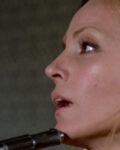CD: Warning Shot (1967)
Return to: Home / Soundtrack Reviews / V to Z
.
Label: La-La Land Records/ Released: June 5, 2012
Tracks & Album Length: 27 tracks / (58:14)
.
Special Notes: 20-page colour booklet with liner notes by Jeff Bond / Limited to 2000 copies..
.
Composer: Jerry Goldsmith
.
.
Review:
Jerry Goldsmith’s Warning Shot comes at the tail-end of the sixties’ jazz orchestra craze, and it’s surprisingly unpretentious in the way jazz is part of the score’s sound and cool style. Even with slight bits of improv, Goldsmith still manages to weave in his own dramatic theme variations for this puzzle mystery by longtime TV director Buzz Kulik, whose credits go beyond the 100 mark.
Goldsmith had made use of jazz in other scores – the Flint diptych was his poke at super-spy jazz – but perhaps the closest relative to WS’s great mix of drama and punchy jazz bits is The Satan Bug (1965), another forgotten film and score gem. Like SB, the score masters no longer exist, but with WB there were the isolated mono stems from the Music & Effects mix. Besides some faint bleed-through, LLL’s mastering and editing have yielded fairly clean mono cuts that capture the richness of this lost score.
WS’s central theme is oft-repeated, but it’s the variations that reinforce why Goldsmith became a top composer by the end of the sixties, and illustrate how effortlessly he was able to glide between idioms without weakening his knack for supporting any scene’s subtext, or a character’s arc with exacting precision.
Offsetting the coasting main theme with its tapping rhythm and elliptical structure is “Miss Alice,” another delicate theme along the lines of Patch of Blue (X)*, with gentle ensemble of woodwinds, chamber strings, and piano. Goldsmith just lets the theme unfold at a loose pace, starting with a vulnerable mood, and working its way to a slight main theme recap, yet it’s the tenderness that affects the listener and adds balance to the score’s otherwise dominant moods of strolling, skulking, suspecting, and evading – emotional and physical states which are characterized by wooden taps, throbbing string bass, and twanging electric guitar with brass & organ stabs; or sublime coolness with up-tempo renditions like “Wealthy Widow.”
The solo trumpet and swaggering big band also presages the same mournful combo in the sleazy Frank Sinatra trashfest The Detective (1968), whereas the use of brass and orchestra gel in the score’s punchy action cues, such as “Valen Gets Messed Up” with gliding piano and looped electronic sounds that cleanly morph into brass chords. The action cues are classic Goldsmith in the way colours shift from striking instrument combinations, but as sparsely scored as WS is, the roughly 29 minutes of original score are filled with inventive writing which keep accentuating the lead character’s dilemma of being a cop searching for evidence to clear his name in an increasingly weird scenario.
Jeff Bond’s liner notes cover all the broad areas leading to and from WS, and it’s no accident the spectre of Twilight Zone* crops up, since the TV series was a mini-training ground where Goldsmith realized he could craft scores in various idioms for any time period or mood. If there’s any two dominant moods within WS, it’s tenderness and action, and the latter comes through in brash, jazzy spurts (“A Little More Time” is a short but memorable build-up to a full jazz orchestral rendition), and funky weirdness (like the grungy vibrato and dirty brass sounds in “Diggin’ for Caesar”).
To flesh out the CD, LLL’s included the original programme material from the only soundtrack album released in tandem with the film. Side A of the Liberty LP featured more robust jazz theme renditions, whereas Side B was a compact best-of compilation mixing Goldsmith’s Von Ryan’s Express* march, The Prize, Patch of Blue*, and The Man from U.N.C.L.E., plus a recap of “Mona Lisa,” which was featured in the film in a bouncy James Last style.
Sy Zentner’s arrangements for WS are great, albeit way too short, whereas the ‘bonus’ Goldsmith themes have dated a fair bit. The overall style is close to Goldsmith’s original thematic intentions, but Zentner had reworked them into the dominant Manciniesque sound of the day.
The Zentner cues are in true stereo, and the CD’s mastering is very clean, but some fans may wish to hold onto the original Liberty LP – if not for the amazing cover art (reproduced for the CD), then the warm analogue sound that made Side A such a treat. Liberty’s stereo albums tended to be beautifully engineered and retain a slight audiophile value, given the original miking scheme focused on very specific instrumental groups and soloists, and placed the listener in the middle of a tight, U-shaped jazz orchestra.
Kulik’s film and TV C.V. is filled with several jazz-scores, including The Twilight Zone episode “A Game of Pool” (Leith Stevens), The Yellow Canary (Kenyon Hopkins), and Riot (Christopher Komeda’s final score).
.
.
© 2012 Mark R. Hasan
.
External References:
IMDB — Soundtrack Album — Composer Filmography
.
Return to: Home / Soundtrack Reviews / V to Z
Category: Soundtrack Reviews


















Connect